Bringing your pet along for the ride is a huge bonus of owning or renting an RV. Hitting the road RV-style with your pups, cats, or even chinchillas is one of the best ways to keep the whole family together. With the rising cost of outside pet care or boarding, it can be a huge budgetary restraint to board a pet for days or even weeks at a time. This makes bringing them along for an RV trip an even more obvious choice.
With more and more RV and camping sites accepting pets, you don’t need to worry as much about which locations will or won’t accept your furry bestie. A lot of RV parks allow pets, and so do a lot of public parks. Plus, with the help of pet tracking technology, having your pets travel with you is a less concerning security venture. You can even install pet cameras to keep an eye on your animals while you’re out adventuring.
That said, there are some considerations to make before taking Rover on the trip of a lifetime. Most of these considerations are around their safety on the road (and off), keeping track of their medical needs, and being aware of whether it will be a fun adventure for them. Once you get all of that under control, the trip is bound to be a joyful one.
Know your pet’s car habits
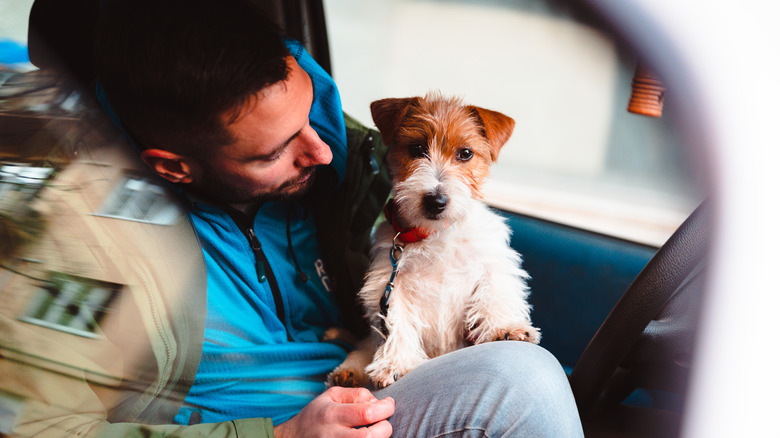
Before bringing your pet on an RV vacation, consider how they fare for an ordinary car ride. Some critters hate cars, and a long ride won’t suit them. There are ways to help a slightly ride-averse pet, but these trips aren’t suited for every animal. Knowing how your pet feels before trying to make them ride for hours is important.
To prepare your pets for a long-distance road trip, try taking them on slightly longer trips than usual to work their way up to the big RV journey. Get them accustomed to riding in their carrier, car seat, or harness so loading up the RV won’t be such a hassle when the big day arrives. Be sure to provide lots of tasty treats during and after the experimental car rides to reinforce the positive side of getting in a vehicle.
Should your pet be more averse to car rides, there may not be a way to break that dislike of them. Try doing a few test rides, as mentioned above, to see if riding somewhere fun will change their mind. Truth be told, some pets just see the car or a vehicle as a means to a no-fun vet appointment. Sometimes exposure therapy helps, but some pets just aren’t meant to be RV riders.
Have all the gear ready
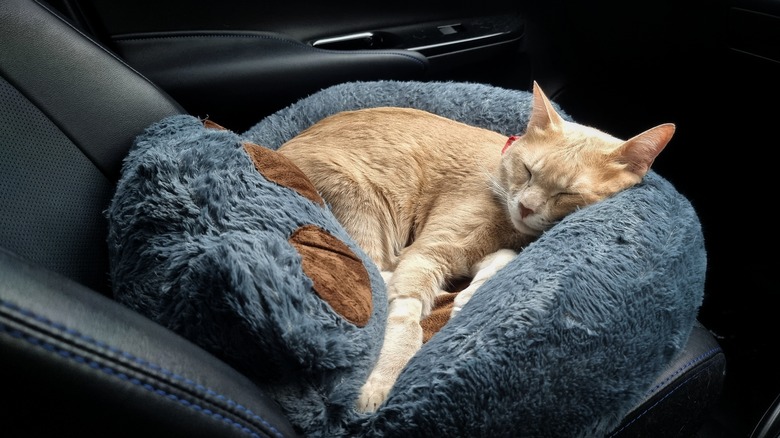
Taking a pet on the road, even in a comfy RV, takes some preparatory planning. You’ll need safety items like buckle harnesses, portable dishes, and a first aid kit. The more into nature your trip, the more vital this preparation will be for your furry friends. You’ll want to pack everything your pet could need if you’re going to be away from society for a while. You don’t want to run out of food, treats, or wound materials if you’re hours away from a pet store.
Gear also includes anything they need to stay safe in the car. Even though car seats or harness buckles might be fine in a regular passenger car, an RV is a much bigger beast. You’ll want a secure cage or crate to keep your pet doubly safe while the vehicle is in motion. The less they can wander off while the RV is moving, the safer they’ll be if something happens — even something as slight as breaking too hard or veering away from an unsafe driver.
Beyond the safety aspect, it’s actually the law in some states — like Hawaii and New Jersey — to have a pet restrained while in a moving vehicle. If they don’t tolerate crating or caging well, try doing small amounts of exposure therapy as with car rides mentioned above. Use positive reinforcement of treats or special toys to encourage the use of the crate or cage before the trip.
Talk to your vet
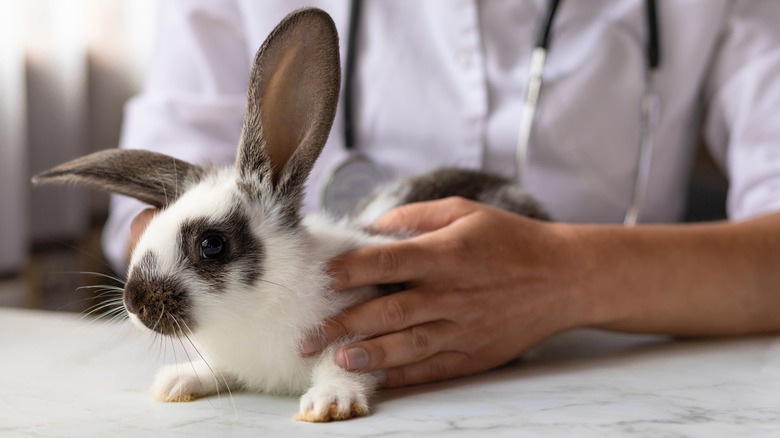
ElenaYakimova/Shutterstock
This tip is especially important for pets with chronic illnesses: You’ll want your vet’s okay before taking off. Your trusted vet can confirm that your pet is healthy enough to travel and offer advice for preparation. For example, if you’re headed to a place where Lyme disease may be commonly reported, your vet might recommend ensuring flea and tick protection. Or, if you plan on visiting dog parks, ask about the canine influenza vaccine as a precaution.
Even if the pet you’re bringing won’t be going outside (like a bunny or indoor cat), it’s a good idea to get them checked out. Critters like ticks can hitch a ride on you and end up on your indoor-only pets without them ever leaving the safety of the RV.
Your vet will also ensure that your pet is up to date on all of their vaccines, even if they aren’t necessarily related to your adventure. This protects your pet and any other pets they may come into contact with while you’re on the road or exploring a state park. Your vet can also help if your pet doesn’t yet have a microchip. They can get that implanted for them and register it in a database, which will help reunite you if you were to get separated.
Keep them comfy

Prystai/Shutterstock
Just like with a standard car, you can’t leave your pet unattended without air flow or temperature regulation. This is especially vital if you are RVing in extreme weather on either end of the hot and cold spectrum. Always remember to keep the heat or air conditioning on when needed and keep the vents open.
Knowing the RV’s gadgets and gizmos is part of keeping your pet the most comfortable. As the American Kennel Club notes, some RVs have sensors that “automatically shut vents if it rains.” You don’t want that to happen. If your RV is in fact equipped with this feature, and your dog is along for the ride, make sure you disable it.
When packing, try to remember some of your pet’s favorite comfort items as well. That includes favorite pillows, blankets, or comfort toys. These can promote relaxation in the RV, especially if the pet is alone at any point. It will remind them of home and bring a sense of peace in an otherwise unfamiliar home vehicle.
Give your pet their space
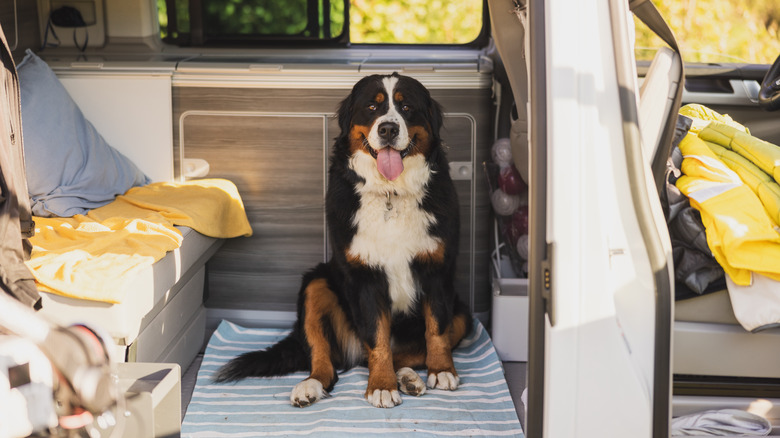
Simonskafar/Getty Images
Humans can get tired of each other when they’re always in contact on vacation, and pets can be the same way. When they’re done being social for the day, they’ll want their own area. It could be as simple as putting their favorite bed, blankets, or pillows under the table area. This little retreat provides them a place to recoup after a day of adventures.
If it doesn’t make sense for your situation to set them up under the table, maybe set them up elsewhere in the RV. A corner of the bedroom area is terrific for pet beds or hideaways. No matter where in the RV you make this area for them, make sure it’s theirs, and any kiddos onboard respect that “pet only” time.
Pets who need more space than others (think big dogs) may want to just have a whole room to themselves sometimes. In this case, a pet gate separating a bedroom from the rest of the RV may be all it takes to give them a little sanctuary. Just don’t forget to check in on them and wrangle them back to their on-the-road safety area before continuing on the drive.
Triple-check the regulations

Robert Alexander/Getty Images
Traveling via RV helps travelers avoid a lot of regulations — particularly around pets. A lot of hotels don’t allow them or have prohibitive fees, making an RV a more reasonable choice. Even so, places like RV parks or campgrounds aren’t always pet-friendly. That’s why it is vital to double-check (better yet, triple-check) the regulations before mapping out your trip. The last thing you’d want is to arrive at a campsite reservation only to find out they don’t allow pets.
While a lot of RV parks let visitors bring pets, there likely are rules around it that usually involve characteristics of the pet or other regulations, like allowing one per vehicle. Some park regulations state that the pet must be under a certain weight or can’t be a specific breed. Oftentimes, breeds like pit bull terriers, Rottweilers, and German Shepherds are not allowed. If an RV park website is not descriptive enough, always ask them ahead of time for specific rules just to be on the safe side.
There usually aren’t as many amenities at a state or national park, though many of them that allow camping also allow pets. Also, many RV parks also have dog parks for your pup to enjoy. That’s why, as mentioned previously, it’s vital to be up to date on vaccines and use flea and tick protection during RV travel.
Leave room for playtime

Przemek Iciak/Shutterstock
Particularly on those long travel days, you need to remember to build in some playtime. Your pets will want exercise and time with you when they aren’t being mentally or physically stimulated. According to PetMD, even pets with lazy streaks and aren’t as playful as others need to have playtime, or they can get depressed. Even something as simple as a special chew toy can keep a pet occupied during their in-motion crate time.
For large RVs, games like fetch or chasing a laser around may be possible. For smaller RVs, items like treats or kibble puzzles filled with toys (with things like peanut butter) or snuffle mats promote mental and physical stimulation with little space needed. Just watch out if the toy is super mobile, as it can get stuck in places like under a bed.
You also want to stop every few hours at least to give your dog some time to stretch their legs and go potty. Sitting around for hours isn’t good for their minds or bladders. Use potty breaks as a good excuse to take a nice walk with your pup for yourself, too, because sitting around isn’t good for humans either.
Give loved ones your itinerary

Vuk Saric/Getty Images
Before heading out, give your map or itinerary to a loved one or two. That way, you have folks to check in with so they can help in case of an accident. If someone knows your route, you have folks who can help locate you if something goes wrong. Just don’t forget to check in with that person periodically to keep them abreast of where you’re at.
It is also a great idea to befriend some of your RV park neighbors. In an emergency like a power outage or storm, while your pets are home alone, these neighbors can inform you of what’s happening. That way, they can give you a call or drop a text to help you get back to your pets more quickly. Otherwise, your pet might be stuck in sweltering heat without air conditioning for hours on end.
Another excellent way to protect your beloved pets while RVing is to attach a sticker or note on the door of your RV with important information in case of an emergency. These stickers can alert neighbors or emergency responders of how many pets are onboard your RV and what type to look for. Try to note their name, too, to make cooperation between your pet and a total stranger easier if they’re in danger.
Be aware of local dangers
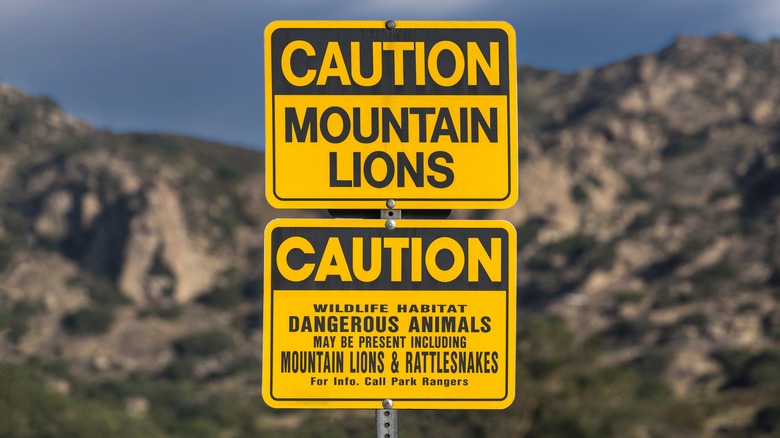
trekandshoot/Shutterstock
Knowing what is dangerous is paramount when exploring somewhere new to you. Before taking your pets to a new location, discover any potential dangers that may be lurking there. Know if there are animals like poisonous snakes or unfamiliar poisonous plants that your pet could encounter. More importantly, know what to do if they come in contact with dangerous objects or animals.
Even if an animal doesn’t seem dangerous, they could pose a threat to your pet. That is true if, for example, you’re camping near a farm and your dog gets loose. Should your dog end up in a cattle pen, the cows could trample them, thinking they’re a threat to any nearby calves. Obviously, more threatening animals like bears or coyotes also need to be minded if you’re camping in a more remote area. Keep an eye out for any postings about sightings, as the seasons make these kinds of animal encounters more or less frequent.
Regardless of the natural danger at your camping destination(s), it’s never a good idea to let your pets run free. Doing so — even for well-trained pets — can result in myriad incidents like being hit by a nearby vehicle or even accidentally targeted by local hunters. For a safe, almost free-roaming adventure, pack a tie-out lead that stakes into the ground. Also, be sure to set up a pet gate if your RV door is propped open so no one accidentally escapes.
Pack copies of important documents
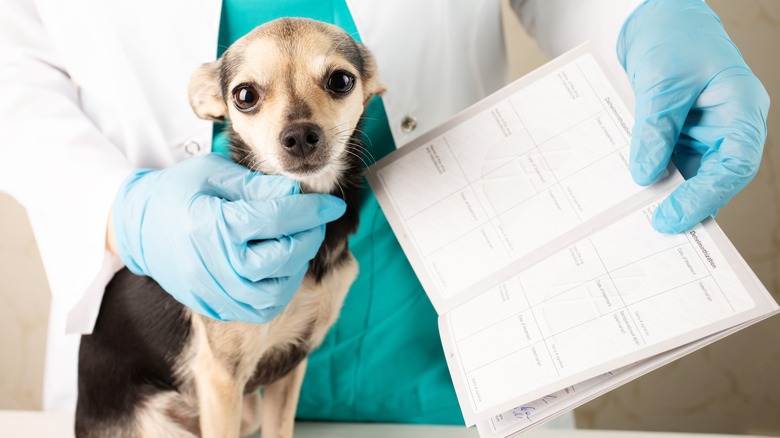
Yta23/Shutterstock
Anytime you travel with your pets, having physical or digital copies of their vaccination records is a good idea. You never know when an incident will arise, and knowing that your pet is protected against Lyme disease if you find a tick on them can be relieving — take that from personal experience. Beyond medical information, it’s always a good idea to also have any pertinent micro-chip information handy, too, just in case they get away from you.
Some camping locations — especially government campgrounds — require proof of vaccines (like rabies) before you can camp there with pets. Even if there isn’t information online about this requirement, it’s a good idea to have the records with you anyway. For example, if your pup has a fight with another dog at the dog park, you’ll want to confirm that they’re protected against rabies. Not just for your own dog’s safety but the safety of whatever pup they got into a scrap with.
Use a pet tracker (but not an AirTag)
![]()
New Africa/Shutterstock
To be on the safe side when traveling with your pet, in an RV or otherwise, it’s a good idea to attach a tracking device to their collar. Pet-safe trackers that are designed specifically for your pet are better for animal use as they pose less of a health risk than other methods, like AirTags.
While AirTags have become an effective way to track luggage, they shouldn’t be your first choice for tracking a pet. That’s because, according to AppleInsider, “vets have warned pet owners against using AirTags to keep tabs on their pets” because the batteries they contain can pose a health risk to a pet’s organs. If the battery starts leaking, it can severely harm your pet. It’s also possible that your pet could get ahold of the AirTag and chew on it, which could cause leakage as well as internal damage and poisoning if they manage to eat it or ingest any battery acid.
Pet-safe tracking collars are a step above the microchip, which helps identify a pet if it’s lost since a tracker can help you locate your pet without someone else finding it first. They partner with your phone so you can see where your pet is in real time. Some pet collars even have trackers built in now, bringing a whole new world of possibilities to folks who want to explore the world with their animals.

